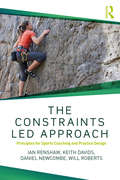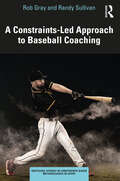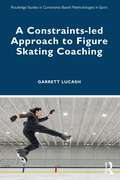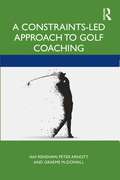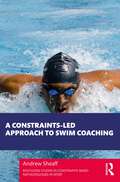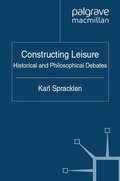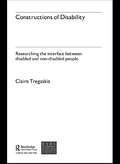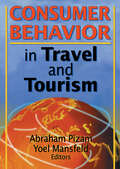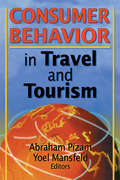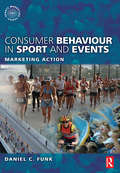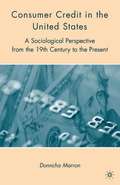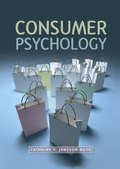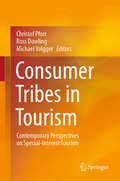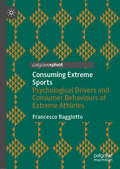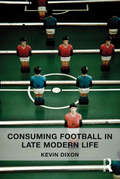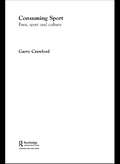- Table View
- List View
The Constraints-Led Approach: Principles for Sports Coaching and Practice Design (Routledge Studies in Constraints-Based Methodologies in Sport)
by Ian Renshaw Keith Davids Daniel Newcombe Will RobertsFor the last 25 years, a constraints-based framework has helped to inform the way that many sport scientists seek to understand performance, learning design and the development of expertise and talent in sport. The Constraints-Led Approach: Principles for Sports Coaching and Practice Design provides students and practitioners with the theoretical knowledge required to implement constraints-led approaches in their work. Seeking to bridge the divide between theory and practice, the book sets out an ‘environment design framework’, including practical tools and guidance for the application of the framework in coaching and skill acquisition settings. It includes chapters on constraints-led approaches in golf, athletics and hockey, and provides applied reading for undergraduate and postgraduate students of motor learning, skill acquisition and developing sport expertise. Providing a thorough grounding in the theory behind constraints-led approaches to skill acquisition, and a foundational cornerstone in the Routledge Studies in Constraints-Based Methodologies in Sport series, this is a vital pedagogical resource for students and practising sports coaches, physical education teachers and sport scientists alike.
The Constraints-Led Approach: Principles for Sports Coaching and Practice Design (Routledge Studies in Constraints-Based Methodologies in Sport)
by Ian Renshaw Keith Davids Daniel Newcombe Will RobertsFor the last 25 years, a constraints-based framework has helped to inform the way that many sport scientists seek to understand performance, learning design and the development of expertise and talent in sport. The Constraints-Led Approach: Principles for Sports Coaching and Practice Design provides students and practitioners with the theoretical knowledge required to implement constraints-led approaches in their work. Seeking to bridge the divide between theory and practice, the book sets out an ‘environment design framework’, including practical tools and guidance for the application of the framework in coaching and skill acquisition settings. It includes chapters on constraints-led approaches in golf, athletics and hockey, and provides applied reading for undergraduate and postgraduate students of motor learning, skill acquisition and developing sport expertise. Providing a thorough grounding in the theory behind constraints-led approaches to skill acquisition, and a foundational cornerstone in the Routledge Studies in Constraints-Based Methodologies in Sport series, this is a vital pedagogical resource for students and practising sports coaches, physical education teachers and sport scientists alike.
A Constraints-Led Approach to Baseball Coaching (Routledge Studies in Constraints-Based Methodologies in Sport)
by Rob Gray Randy SullivanA Constraints-Led Approach to Baseball Coaching presents a new approach to baseball coaching and practice. Applying a CLA to the player development process across the skill spectrum from the beginners to elite, this book uses practical examples to demonstrate the theoretical principles of the constraints-led coaching style embedded in research showing the numerous benefits of the approach. This book incorporates case studies and examples of how constraints are manipulated to develop more adaptable players that can perform at a higher level with a reduced risk of injury, shifting the reader’s view of skill acquisition from the concept of the one “correct” solution, acquired through repetition, to the ecological dynamics framework focused on variability, adaptability, and self-organization. Individual chapters cover major topics such as hitting, pitching, and fielding for players from Little League to the pros. This book illustrates the underlying principles so that coaches can develop their own practice activities. A Constraints-Led Approach to Baseball Coaching is a key reading for undergraduate students and practicing sports coaches, physical education teachers and sport scientists alike as well as practicing players and coaches in baseball and related sports.
A Constraints-Led Approach to Baseball Coaching (Routledge Studies in Constraints-Based Methodologies in Sport)
by Rob Gray Randy SullivanA Constraints-Led Approach to Baseball Coaching presents a new approach to baseball coaching and practice. Applying a CLA to the player development process across the skill spectrum from the beginners to elite, this book uses practical examples to demonstrate the theoretical principles of the constraints-led coaching style embedded in research showing the numerous benefits of the approach. This book incorporates case studies and examples of how constraints are manipulated to develop more adaptable players that can perform at a higher level with a reduced risk of injury, shifting the reader’s view of skill acquisition from the concept of the one “correct” solution, acquired through repetition, to the ecological dynamics framework focused on variability, adaptability, and self-organization. Individual chapters cover major topics such as hitting, pitching, and fielding for players from Little League to the pros. This book illustrates the underlying principles so that coaches can develop their own practice activities. A Constraints-Led Approach to Baseball Coaching is a key reading for undergraduate students and practicing sports coaches, physical education teachers and sport scientists alike as well as practicing players and coaches in baseball and related sports.
A Constraints-led Approach to Figure Skating Coaching (Routledge Studies in Constraints-Based Methodologies in Sport)
by Garrett LucashMotor skill acquisition and athlete development practices are rapidly evolving. Positioned at the forefront of this evolution, the constraints-led approach encourages practitioners to consider the athlete as a whole person, with unique traits, abilities, and capacities. Accordingly, an athlete’s competitive success lies in the practitioner’s ability to adapt programming to the unique needs of each athlete and to facilitate the athlete-environment relationship. A Constraints-led Approach to Figure Skating Coaching applies contemporary motor skill acquisition and athlete development practices to figure skating. The book encourages coaches to think about why they coach, the athletes they want to support, and the goals they want their program to achieve. It informs coaches how to transform these core considerations into the driving inspiration for their daily coaching practices including assessment methods, the coach-athlete relationship, practice structure, competition preparation, and conceptions of technique. The lessons here are founded on the constraints-led approach. They are personal, yet broadly inclusive to the global sports programming market. The book is written through a ‘conversive’ voice and is accessible to a broad audience interested in athlete development and programming such as coaches, athletes and parents. At the same time, academics and students in the areas of sport coaching, biomechanics, motor skill acquisition, strength and conditioning, and related disciplines will find interest in the insights provided from this underrepresented niche in sports.
A Constraints-led Approach to Figure Skating Coaching (Routledge Studies in Constraints-Based Methodologies in Sport)
by Garrett LucashMotor skill acquisition and athlete development practices are rapidly evolving. Positioned at the forefront of this evolution, the constraints-led approach encourages practitioners to consider the athlete as a whole person, with unique traits, abilities, and capacities. Accordingly, an athlete’s competitive success lies in the practitioner’s ability to adapt programming to the unique needs of each athlete and to facilitate the athlete-environment relationship. A Constraints-led Approach to Figure Skating Coaching applies contemporary motor skill acquisition and athlete development practices to figure skating. The book encourages coaches to think about why they coach, the athletes they want to support, and the goals they want their program to achieve. It informs coaches how to transform these core considerations into the driving inspiration for their daily coaching practices including assessment methods, the coach-athlete relationship, practice structure, competition preparation, and conceptions of technique. The lessons here are founded on the constraints-led approach. They are personal, yet broadly inclusive to the global sports programming market. The book is written through a ‘conversive’ voice and is accessible to a broad audience interested in athlete development and programming such as coaches, athletes and parents. At the same time, academics and students in the areas of sport coaching, biomechanics, motor skill acquisition, strength and conditioning, and related disciplines will find interest in the insights provided from this underrepresented niche in sports.
A Constraints-Led Approach to Golf Coaching (Routledge Studies in Constraints-Based Methodologies in Sport)
by Ian Renshaw Peter Arnott Graeme McDowallWhile the popularity of golf is coming under increased pressure, it continues to hook millions of players. However, the complexity of the game and the extremely high level of precision required to hit the ball consistently well means that it is a game that is difficult to even become ‘good’ at, let alone master. Consequently, irrespective of whether the player is a weekend golfer, a club member, or a tour professional, the search for the key to playing good golf feeds an insatiable desire for ideas and tips to improve golf performance and bring one’s handicap down. However, traditional coaching, with its primary focus on developing the perfect swing is not leading to a reduction in handicaps and the time is ripe for a new approach. This book aims to fill this void and is a landmark text for golf coaches and players about applying a constraints-led approach (CLA) to golf coaching. In this book, two golf coaches, Pete Arnott and Graeme McDowall talk to Ian Renshaw to demonstrate how their practice is driven and inspired by their alignment to a CLA. A Constraints-Led Approach to Golf Coaching includes case studies and examples of how constraints are manipulated to induce adaption in the technical, tactical (or put in golf terms, course management), physiological, and psychological development mechanisms needed to improve at golf. Examples cover coaching from their work with beginners, high handicappers, aspirant tour players, and elite players looking to make the ‘tour’.
A Constraints-Led Approach to Golf Coaching (Routledge Studies in Constraints-Based Methodologies in Sport)
by Ian Renshaw Peter Arnott Graeme McDowallWhile the popularity of golf is coming under increased pressure, it continues to hook millions of players. However, the complexity of the game and the extremely high level of precision required to hit the ball consistently well means that it is a game that is difficult to even become ‘good’ at, let alone master. Consequently, irrespective of whether the player is a weekend golfer, a club member, or a tour professional, the search for the key to playing good golf feeds an insatiable desire for ideas and tips to improve golf performance and bring one’s handicap down. However, traditional coaching, with its primary focus on developing the perfect swing is not leading to a reduction in handicaps and the time is ripe for a new approach. This book aims to fill this void and is a landmark text for golf coaches and players about applying a constraints-led approach (CLA) to golf coaching. In this book, two golf coaches, Pete Arnott and Graeme McDowall talk to Ian Renshaw to demonstrate how their practice is driven and inspired by their alignment to a CLA. A Constraints-Led Approach to Golf Coaching includes case studies and examples of how constraints are manipulated to induce adaption in the technical, tactical (or put in golf terms, course management), physiological, and psychological development mechanisms needed to improve at golf. Examples cover coaching from their work with beginners, high handicappers, aspirant tour players, and elite players looking to make the ‘tour’.
A Constraints-Led Approach to Swim Coaching (Routledge Studies in Constraints-Based Methodologies in Sport)
by Andrew SheaffMotor skill acquisition and athlete development practices are rapidly evolving. Positioned at the forefront of this evolution, the constraints-led approach encourages practitioners to consider the athlete as a whole person, with unique traits, abilities, and capacities. Accordingly, an athlete’s competitive success lies in the practitioner’s ability to adapt their programming to the unique needs of each athlete and to develop an understanding of the athlete-environment relationship. A Constraints-Led Approach to Swim Coaching applies contemporary motor skill acquisition and athlete development practices to swimming. This book encourages coaches to reconsider how they approach skill development in a sport that requires considerable physical training and highly efficient movement. It presents a framework for identifying the various constraints that determine the ability to perform at a high level. It then offers coaches practical examples to navigate the manipulation of constraints to support the development of physical capacities and the ability to effectively utilize those capacities through efficient movement. These frameworks are broadly inclusive to the global sports programming market. This book is written through a “conversive” voice and is accessible to a broad audience interested in athlete development and programming such as coaches, sport scientists, support staff, athletes, and parents. At the same time, academics and students in the areas of sport coaching, biomechanics, motor skill acquisition, strength and conditioning, and related disciplines will find interest in the insights provided from this underrepresented niche in sports.
A Constraints-Led Approach to Swim Coaching (Routledge Studies in Constraints-Based Methodologies in Sport)
by Andrew SheaffMotor skill acquisition and athlete development practices are rapidly evolving. Positioned at the forefront of this evolution, the constraints-led approach encourages practitioners to consider the athlete as a whole person, with unique traits, abilities, and capacities. Accordingly, an athlete’s competitive success lies in the practitioner’s ability to adapt their programming to the unique needs of each athlete and to develop an understanding of the athlete-environment relationship. A Constraints-Led Approach to Swim Coaching applies contemporary motor skill acquisition and athlete development practices to swimming. This book encourages coaches to reconsider how they approach skill development in a sport that requires considerable physical training and highly efficient movement. It presents a framework for identifying the various constraints that determine the ability to perform at a high level. It then offers coaches practical examples to navigate the manipulation of constraints to support the development of physical capacities and the ability to effectively utilize those capacities through efficient movement. These frameworks are broadly inclusive to the global sports programming market. This book is written through a “conversive” voice and is accessible to a broad audience interested in athlete development and programming such as coaches, sport scientists, support staff, athletes, and parents. At the same time, academics and students in the areas of sport coaching, biomechanics, motor skill acquisition, strength and conditioning, and related disciplines will find interest in the insights provided from this underrepresented niche in sports.
Constructing Leisure: Historical and Philosophical Debates
by K. SpracklenThis book looks back at the meaning and purpose of leisure in the past. But this is not a simple social history of leisure. It is not enough to write a history of leisure on its own in fact, it is impossible without engaging in the debate about what counts as leisure (in the present and in the past). Writing a history of leisure, then, entails writing a philosophy of leisure: and any history needs to be a philosophical history as well. That is the purpose of this book. It provides an account of leisure through historical time, how leisure was constructed and understood by historical actors, how communicative reason and free will interacted with instrumentality at different times, how historians have reconstructed past leisure through historiography, and finally, how writers have perceived the meaning and purpose of leisure in alternative histories. Providing a sweeping overview of the field, Karl Spracklen charts how the concept of leisure was understood in Ancient history, through to modern times, and looks at leisure in different societies and cultures including Byzantium and Asian civilizations, as well as looking at leisure and Islam. Spracklen concludes with a chapter on future histories of leisure.
Constructions of Disability: Researching Inclusion in Community Leisure
by Claire TregaskisThis innovative book discusses the meaning of 'inclusion' through the exploration of the interactions between disabled and non-disabled people at a community leisure centre. By exploring the nature of this interface, an understanding of how people create potential for both disability and inclusion is revealed. This book takes a very different approach to that of existing texts, which have tended to concentrate mainly on disabled people's exclusion. The advantage of this new approach is that it adds an extra dimension to our understanding of how discriminatory practice is variously perpetuated and challenged..Constructions of Disability is valuable reading for all people who are working towards increased social inclusion for disabled people, including theorists and students of disability studies and learning difficulty, leisure management and disability service providers, and their families. Using a practical case study approach, it explores the impact that social interaction between disabled and non-disabled people can have increasing or decreasing disabled people's opportunities for inclusion. Examples of both inclusive and discriminatory practice are described in detail, and the positive and negative effects of these actions on the participants are demonstrated and discussed. This insightful book offers a wide range of practical suggestions for the future development of more inclusive theory, policy and practice.
Constructions of Disability: Researching Inclusion in Community Leisure
by Claire TregaskisThis innovative book discusses the meaning of 'inclusion' through the exploration of the interactions between disabled and non-disabled people at a community leisure centre. By exploring the nature of this interface, an understanding of how people create potential for both disability and inclusion is revealed. This book takes a very different approach to that of existing texts, which have tended to concentrate mainly on disabled people's exclusion. The advantage of this new approach is that it adds an extra dimension to our understanding of how discriminatory practice is variously perpetuated and challenged..Constructions of Disability is valuable reading for all people who are working towards increased social inclusion for disabled people, including theorists and students of disability studies and learning difficulty, leisure management and disability service providers, and their families. Using a practical case study approach, it explores the impact that social interaction between disabled and non-disabled people can have increasing or decreasing disabled people's opportunities for inclusion. Examples of both inclusive and discriminatory practice are described in detail, and the positive and negative effects of these actions on the participants are demonstrated and discussed. This insightful book offers a wide range of practical suggestions for the future development of more inclusive theory, policy and practice.
Consumer Behavior in Travel and Tourism
by Kaye Sung Chon Abraham Pizam Yoel MansfeldContaining original and previously unpublished theoretical and empirical studies, Consumer Behavior in Travel and Tourism will give professionals, professors, and researchers in the field up-to-date insight and information on trends, happenings, and findings in the international hospitality business arena. A great resource for educators, this book is complete with learning objectives, concept definitions, and even review questions at the end of each chapter. From this book, readers will understand and learn the needs and preferences of tourists and how to investigate the process of destination and product selection to help provide customers with products and services that will best meet their needs.In today's highly competitive business environment, understanding travel behavior is imperative to success. Consumer Behavior in Travel and Tourism brings together several studies in one volume, representing the first attempt to explore, define, analyze, and evaluate the consumption of tourist and travel products. This guide offers essential research strategies and methods that enables readers to determine the wants and needs of tourists, including: discussing and evaluating the main factors that affect consumer behavior in travel and tourism, such as travel motivation, destination choice, and the consequent travel behavior exploring the various decision-making processes of consumers that leads to consequent destination choices through case study analysis and marketing suggestions determining customer expectations of products through a variety of research techniques in order to find ways of improving satisfaction examining selected research tools, such as product positioning and repositioning and using perceptual maps, to evaluate the market implications of using qualitative and/or quantitative research techniques detecting and analyzing the relative roles individual, environmental, socioeconomic, and demographic factors play in choosing travel destinationsFull of detailed charts and graphs, Consumer Behavior in Travel and Tourism illustrates key points to give you a better understanding of important facts and findings in the field.
Consumer Behavior in Travel and Tourism
by Kaye Sung Chon Abraham Pizam Yoel MansfeldContaining original and previously unpublished theoretical and empirical studies, Consumer Behavior in Travel and Tourism will give professionals, professors, and researchers in the field up-to-date insight and information on trends, happenings, and findings in the international hospitality business arena. A great resource for educators, this book is complete with learning objectives, concept definitions, and even review questions at the end of each chapter. From this book, readers will understand and learn the needs and preferences of tourists and how to investigate the process of destination and product selection to help provide customers with products and services that will best meet their needs.In today's highly competitive business environment, understanding travel behavior is imperative to success. Consumer Behavior in Travel and Tourism brings together several studies in one volume, representing the first attempt to explore, define, analyze, and evaluate the consumption of tourist and travel products. This guide offers essential research strategies and methods that enables readers to determine the wants and needs of tourists, including: discussing and evaluating the main factors that affect consumer behavior in travel and tourism, such as travel motivation, destination choice, and the consequent travel behavior exploring the various decision-making processes of consumers that leads to consequent destination choices through case study analysis and marketing suggestions determining customer expectations of products through a variety of research techniques in order to find ways of improving satisfaction examining selected research tools, such as product positioning and repositioning and using perceptual maps, to evaluate the market implications of using qualitative and/or quantitative research techniques detecting and analyzing the relative roles individual, environmental, socioeconomic, and demographic factors play in choosing travel destinationsFull of detailed charts and graphs, Consumer Behavior in Travel and Tourism illustrates key points to give you a better understanding of important facts and findings in the field.
Consumer Behaviour in Sport and Events
by Daniel Funk Kostas Alexandris Heath McDonaldConsumer Behaviour in Sport and Events emphasises the role of consumer behaviour in sport marketing. Given the social, economic, and environmental benefits of sport events, the challenge for marketers is to understand the complexity of sport and event participation. Through a heightened understanding of consumer behaviour, marketers are able to develop communication strategies to enhance the experience, while identifying key elements of the consumer’s decision-making process. This book provides students and industry professionals with the knowledge and skills necessary to meet the current marketing challenges facing professionals working in the sport and event industries. This comprehensive text covers a wide range of determinants that influence both active recreation and passive spectator participation, and offers the reader: A detailed understanding of the personal, psychological and environmental factors that influence sport and event related consumer behaviour A basis for the development of marketing actions useful in sport and related business, community and government sectors A comprehensive understanding of how individuals associate themselves with sport and event products and services A quick and simple segmentation tool to guide discussion of marketing actions and strategies for four stages of involvement with sport and events A comprehensive events checklist to help understand marketing actions related to the development, promotion and delivery of a sport event. Sport and event consumer behaviour is a rapidly growing area of interest and this book is considered a valuable resource for those involved in the sport and events industries from students to marketers to academics.
Consumer Behaviour in Sport and Events
by Daniel Funk Kostas Alexandris Heath McDonaldConsumer Behaviour in Sport and Events emphasises the role of consumer behaviour in sport marketing. Given the social, economic, and environmental benefits of sport events, the challenge for marketers is to understand the complexity of sport and event participation. Through a heightened understanding of consumer behaviour, marketers are able to develop communication strategies to enhance the experience, while identifying key elements of the consumer’s decision-making process. This book provides students and industry professionals with the knowledge and skills necessary to meet the current marketing challenges facing professionals working in the sport and event industries. This comprehensive text covers a wide range of determinants that influence both active recreation and passive spectator participation, and offers the reader: A detailed understanding of the personal, psychological and environmental factors that influence sport and event related consumer behaviour A basis for the development of marketing actions useful in sport and related business, community and government sectors A comprehensive understanding of how individuals associate themselves with sport and event products and services A quick and simple segmentation tool to guide discussion of marketing actions and strategies for four stages of involvement with sport and events A comprehensive events checklist to help understand marketing actions related to the development, promotion and delivery of a sport event. Sport and event consumer behaviour is a rapidly growing area of interest and this book is considered a valuable resource for those involved in the sport and events industries from students to marketers to academics.
Consumer Credit in the United States: A Sociological Perspective from the 19th Century to the Present
by D. MarronIt is commonly imagined that in recent years the rampant growth of consumer credit has lured American consumers into a crippling state of indebtedness, a state that has upended old cultural values of Puritan thrift and stimulated a frenzy of consumption. Drawing on the sociological concept of government and informed by a historical perspective, Marron presents a much more complex and nuanced reality. From its early antecedents in nineteenth century salary lending and instalment selling, she shows how the emergence and growth of consumer credit in the United States have always been subject to shifting regimes of control and regulation.
Consumer Psychology (UK Higher Education OUP Psychology Psychology)
by Cathrine Jansson-BoydWhy do people behave and think the way they do?What makes people choose certain products and services?How does consumption affect our everyday lives?Informed by psychological theory and supported by research, this book provides an overall understanding of consumer behaviour and underlying thought processes. Psychology is central to an effective understanding of consumer behaviour and this book shows how it can be used to explain why people choose certain products and services, and how this affects their behaviour and psychological well-being.It explores key theories within social, cognitive and developmental psychology to show how psychology can help explain consumption behaviours. These include: Memory LearningPerceptionAttentionEmotionsDecision making Each chapter features an introduction, key terms and a summary as well as study questions or class exercises that encourage you to think critically about the subjects covered. Each topic is illustrated with real-life examples, including adverts and case studies, allowing you to relate the theory to everyday life.Written in a clear and accessible style, this book is essential reading for students of consumer psychology. It is also important reading for anyone studying consumption, whether in marketing, consumer behaviour, sociology, anthropology or business studies.
Consumer Tribes in Tourism: Contemporary Perspectives on Special-Interest Tourism
by Christof Pforr Ross Dowling Michael VolggerThis book adopts a collectivist perspective on special interest tourism consumption, bringing together research on ‘special interest tourism’ and ‘niche tourism’ as well as more recent research into the interdisciplinary applications of the sociological concept of neo‐tribes. It promotes a shift in perspective away from special interest tourism understood as a sum of similarly motivated individuals, to a collective view of special interest tourists who share common characteristics (e.g., shared values, beliefs and mutual interests) and group structures. This approach provides a better understanding of groupings that are not unified by a common tourism motivation, but brought together by otherwise conditioned commonalities in actual behavior triggered by supply-side contexts (e.g., Airbnb). The book considers tourism micro‐segments as consumer tribes (i.e., as symbolic communities) in which individuals are embedded and loosely bound together.As there is limited research on the collectivist perspective on special interest tourism consumption, in the first part the book’s conceptual/theoretical discourse contributes to a better understanding of ‘groupings’ in tourism behavior but also collectives that are not unified by a common tourism motivation. Presenting international examples, the book explores in Part 2 the group culture of a range of tourist tribes by describing emerging tourism micro-segments, identifying shared identities, and analyzing their collective mechanisms.
Consuming Extreme Sports: Psychological Drivers and Consumer Behaviours of Extreme Athletes
by Francesco RaggiottoThis book explores the consumption behaviour of ‘extreme’ athletes from a quantitative perspective. Extreme sports are a multi-billion-dollar industry. The behaviour of athletes who participate in them differs from the majority of consumers in that they voluntarily seek out risky and dangerous situations that other consumers actively avoid. It has therefore been suggested that these consumer-athletes may have a unique psychology in this regard. The book adopts a novel approach based on established psychological theories concerning the behaviour of extreme individuals, applying and translating them into marketing research and practice. It discusses how specific psychological drivers impact the consumption behaviour of consumer-athletes and a variety of marketing-relevant outcomes. By demonstrating that extreme consumers are characterized by a unique psychology that leads them to act and think differently, this book offers scholars deeper insights into consumer behaviour, while also helping practitioners target this lucrative marketing segment more effectively.
Consuming Football in Late Modern Life
by Kevin DixonConsuming Football in Late Modern Life explores the phenomenon of football (soccer) fandom as consumption in the age of late modernity. By centralising fandom within the sociology of consumption, the book examines how this phenomenon equates to a fluid series of consumption activities that are practiced in the course of everyday life. In turn, the work departs from much of the existing literature that features exceptional properties of fanatical fans, in order to emphasise the position that seemingly trivial acts of consumption can have a profound influence on the construction, maintenance and evolution of football fandom cultures. Containing up to date research findings derived from a programme of interviews with a sample of football fans, Kevin Dixon examines the social, emotional, economic and technological implications of consumption as fans participate in and respond to the demands of consumer life.
Consuming Football in Late Modern Life
by Kevin DixonConsuming Football in Late Modern Life explores the phenomenon of football (soccer) fandom as consumption in the age of late modernity. By centralising fandom within the sociology of consumption, the book examines how this phenomenon equates to a fluid series of consumption activities that are practiced in the course of everyday life. In turn, the work departs from much of the existing literature that features exceptional properties of fanatical fans, in order to emphasise the position that seemingly trivial acts of consumption can have a profound influence on the construction, maintenance and evolution of football fandom cultures. Containing up to date research findings derived from a programme of interviews with a sample of football fans, Kevin Dixon examines the social, emotional, economic and technological implications of consumption as fans participate in and respond to the demands of consumer life.
Consuming Sport: Fans, Sport and Culture
by Garry CrawfordConsuming Sport offers a detailed consideration of how sport is experienced and engaged with in the everyday lives, social networks and consumer patterns of its followers. It examines the processes of becoming a sport fan, and the social and moral career that supporters follow as their involvement develops over a life-course.The book argues that while for many people sport matters, for many more, it does not. Though for some sport is significant in shaping their social and cultural identity, it is often consumed and experienced by others in quite mundane and everyday ways, through the media images that surround us, conversations overheard and in the clothing of people we pass by.As well as developing a new theory of sport fandom the book links this discussion to wider debates on audiences, fan cultures and consumer practices. The text argues that for far too long consideration of sport fans has focused on exceptional forms of support ignoring the myriad of ways in which sport can be experienced and consumed in everyday life.
Consuming Sport: Fans, Sport and Culture
by Garry CrawfordConsuming Sport offers a detailed consideration of how sport is experienced and engaged with in the everyday lives, social networks and consumer patterns of its followers. It examines the processes of becoming a sport fan, and the social and moral career that supporters follow as their involvement develops over a life-course.The book argues that while for many people sport matters, for many more, it does not. Though for some sport is significant in shaping their social and cultural identity, it is often consumed and experienced by others in quite mundane and everyday ways, through the media images that surround us, conversations overheard and in the clothing of people we pass by.As well as developing a new theory of sport fandom the book links this discussion to wider debates on audiences, fan cultures and consumer practices. The text argues that for far too long consideration of sport fans has focused on exceptional forms of support ignoring the myriad of ways in which sport can be experienced and consumed in everyday life.
